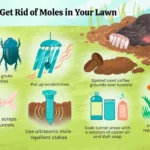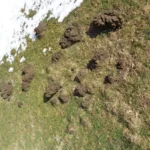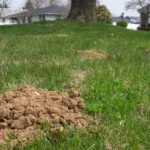It’s a beautiful morning and you step out into your lawn only to find that your beloved garden looks like it has been subjected to an earthquake. The soil is raised and loose, and you notice small mounds of earth all over. As perplexing as it may seem, these signs could be an indication of mole activity. In this comprehensive guide, we will show you step-by-step how to identify mole tunnels and discuss the different types of tunnels. We will also offer tips on how to prevent mole activity and protect your lawn from their destructive behavior. So let’s get started!
What are Moles?
One might have spotted mole tunnels in their garden or lawn, wondering what kind of creature creates them. Moles are small mammals that belong to the Talpidae family. They are usually small in size, weighing between 2 to 8 ounces, and have large front paws that aid them in digging. Moles are often confused with voles, but they are entirely different animals. While voles create shallow tunnels, moles dig deep into the soil in search of food. Understanding the behavior of moles can help identify their tunnels and take the necessary steps to prevent them from causing damage. To learn more about telling the difference between mole and vole tunnels, visit our article on mole vs. vole tunnels.
Why are Moles a Problem?
Moles might seem harmless, but they can cause a variety of problems if left unchecked. Here are some of the reasons why moles are a problem:
| Moles eat earthworms and insects that are beneficial to soil health. | As moles dig up soil, they can eat earthworms and other insects that are beneficial to soil health. This can disrupt the soil ecosystem and reduce the overall health of your lawn or garden. |
| Moles can damage the roots of plants. | As moles tunnel through the ground, they can damage the roots of plants, shrubs, and trees in your lawn or garden, which can lead to stunted growth and even death. |
| Mole tunnels can create tripping hazards. | As moles tunnel through the soil, they can create raised ridges and soft spots in your lawn or garden, which can be a tripping hazard for people and pets. |
| Moles can ruin the aesthetic of your lawn or garden. | Their digging can create unsightly mole hills and ridges throughout your lawn. |
| Moles can attract other pests. | If you have a mole problem, it can also attract other pests to your lawn or garden. For example, skunks will eat moles and might dig through your lawn to do so. |
| Moles can create excess soil. | As moles dig tunnels, they create excess soil which can spill over into your lawn or garden. This can make your lawn or garden uneven and hard to maintain. |
It’s important to address a mole problem as soon as possible to prevent these issues from getting worse. Look for mole tunnels and other signs of mole activity in your yard, and take steps to prevent them from causing damage. If you do need to fill in mole hills, make sure to do so carefully to avoid injuring the grass around them.
Identifying Mole Tunnels
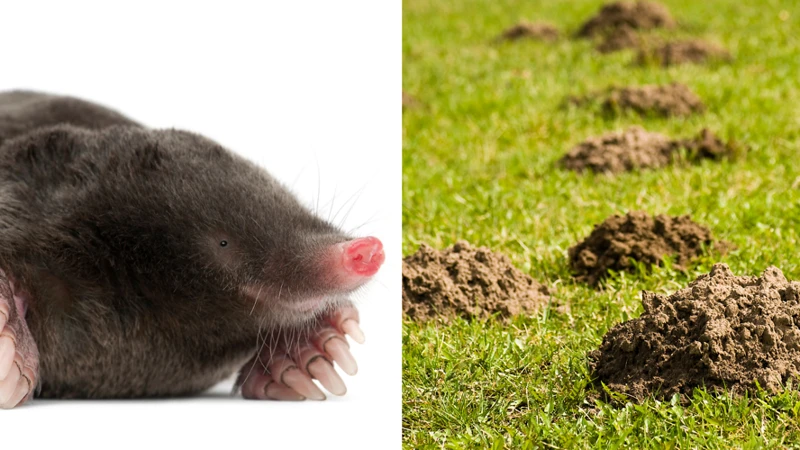
To effectively control mole infestations, it’s crucial to be able to identify the tunnels they create. These tunnels are what moles use to travel underground and find food. Here are some steps you can follow to help you identify mole tunnels:
Step 1: Look for Molehills
Molehills are small mounds of soil that are pushed up from the earth by moles digging their tunnels. These mounds can be found in and around areas where moles are active. To find molehills, look for raised areas of soil on your lawn, garden or farm.
Step 2: Check for Raised Soil
Aside from molehills, another way to identify mole tunnels is by checking for raised soil on the ground. This could show up as a ridge running along your lawn or garden. It’s caused by the soil being pushed up by the mole as it digs its tunnel.
Step 3: Look for ‘Mole Runs’
Mole runs are tunnels that lie just beneath the surface of the soil. They look like “ridges” on the ground, and can often be seen snaking their way across lawns or gardens. To find them, simply walk around the area you suspect has mole activity and look for raised ridges or “waves” in the soil.
Step 4: Check for Damage to Roots and Plants
When tunnels are created, the soil and roots surrounding them can be displaced. This can cause visible damage to your plants, flowers, and lawn. Look for signs such as wilting plants or discolored patches of turf. Such damage could also indicate the presence of other underground pests like voles or gophers.
Identifying mole tunnels is an important step in controlling their damage. And while all tunnels may look similar, it’s important to differentiate between the different types. In the next section of the article, we’ll discuss the various types of mole tunnels you might come across.
Step 1: Look for Molehills
Have you noticed strange mounds of soil appearing on your lawn lately? Don’t be alarmed, as this is a strong indication of the presence of moles. These little creatures create tunnels underground, digging through soil and uprooting plants as they go. The first step in identifying mole tunnels is to look for molehills. These are mounds of soil that have been brought up from the tunnels and deposited on the surface. If you’re not sure how to fill in those mole hills, check out our guide here.
Step 2: Check for Raised Soil
One of the most noticeable signs of mole activity are the raised soil mounds present on the ground. To identify mole tunnels, it’s important to check for these mounds. They’re essentially small mounds of soil that rise where moles have dug and pushed up the soil.
Step 2: Check for Raised Soil
To check for raised soil, take a walk around your yard and scan for small mounds of soil that rise. Moles typically construct their tunnels and push up the soil at regular intervals (every few inches to a few feet), so the mounds may appear in a line or scattered throughout your lawn.
Here’s a helpful table with more information about raised soil that can help you easily identify mole activity:
| Sign of Mole Activity | Description |
|---|---|
| Raised Soil Mounds | Small, conical mounds of soil that rise regularly along mole tunnels. |
| Cracks in Soil | Small cracks on the soil surface where moles have dug deep. |
| Depression in Lawn | Weakness in soil surface can result in shallow depressions in the lawn or grass. |
It’s important to note that while raised soil mounds are a good indicator of mole activity, they’re not the only sign. Moles can dig tunnels without pushing up the soil, which is why it’s recommended to check for other signs as well.
Step 3: Look for ‘Mole Runs’
One method to identify mole tunnels is to look for ‘mole runs’. These are ridges or raised areas of soil that have been pushed up by moles as they tunnel underground. To effectively identify ‘mole runs’, follow these steps:
- Search for raised areas of soil on the surface of your lawn or garden. These ridges, which can be up to several inches wide, are formed as moles tunnel through the soil, pushing up dirt as they go.
- Look for a line or series of raised ridges in a straight path. This is one indication that you may have found a ‘mole run’. These runs can stretch up to several feet in length and may move in different directions across your property.
- Another way to spot a mole run is to gently press down on the raised area with your foot. If the soil compresses, it is an indication that moles have tunnelled through that area and created a ‘run’.
- Be aware that mole runs may be difficult to spot, especially if they have been recently formed. But the more you search, the more likely you are to find them and be able to take action to eliminate the moles from your lawn or garden.
By looking for ‘mole runs’ in your yard or garden, you may be able to pinpoint areas where moles are actively tunneling and causing damage. This can help you take steps to control the mole population and protect your lawn and plants from destruction.
Step 4: Check for Damage to Roots and Plants
Another way to identify mole tunnels is by checking for damage to roots and plants in your yard. Follow these steps to properly identify such damage:
- Step 1: Inspect your lawn and garden. Look for wilting or yellowing plants. If there are areas where the soil seems raised and is surrounded by dying or dead plants, it may be due to mole activity.
- Step 2: Identify if the damage is caused by moles. If the roots of the plants have been dug up or gnawed away, it’s likely that moles have been present.
- Step 3: Pay attention to the shape of the damage to your plants. If the damage is in the form of surface or underground tunnels, then moles are the most likely culprit for the damage.
- Step 4: Check the area for mole hills or raised soil. If the roots of plants in these areas have been damaged or destroyed, there are likely mole tunnels underneath causing the damage.
It’s important to properly identify the cause of damage to your plants, as moles are not the only pesky animal that can cause harm to your yard. Rabbits and other burrowing rodents can also cause damage to plants by gnawing on tree bark and foliage. It’s best to make sure that you are correctly identifying the cause of damage before trying to implement any control measures.
Types of Mole Tunnels
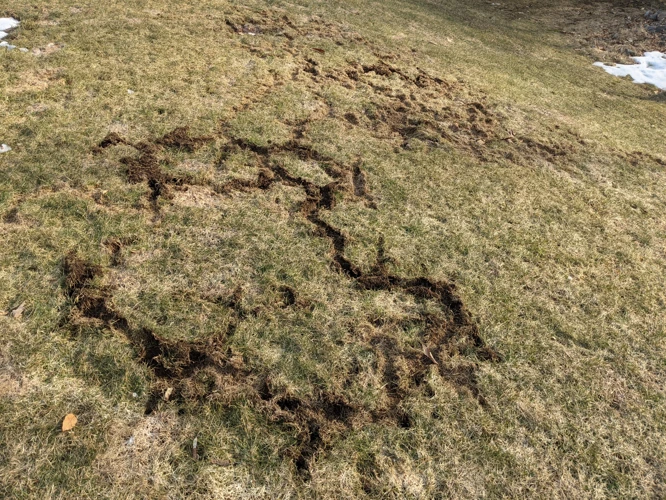
Now that you have identified the presence of mole tunnels, it’s important to understand the different types of tunnels moles create. By understanding the types of tunnels, you can better understand the habits and patterns of the moles and implement effective prevention methods. Here are some of the distinct types of mole tunnels that you may come across, each serving a unique purpose for the moles.
Subsurface Tunnels
Subsurface tunnels are the most common type of tunnels created by moles. They are located underground and are used by the moles to search for food. These tunnels are typically located between 2 and 12 inches below the surface and can be identified by a raised ridge that runs along the top of the tunnel.
Characteristics of Subsurface tunnels
| Appearance | A raised ridge that runs along the top of the tunnel |
| Depth | Located between 2 and 12 inches below the surface |
| Function | Used by the moles to search for food |
Subsurface tunnels are used by moles to travel great distances in search of food. They may also build feeding tunnels that lead off from the main subsurface tunnel. These feeding tunnels are used by the moles to search for specific types of food, such as grubs and other insects.
While subsurface tunnels are not visible on the surface, they can still cause damage to lawns and gardens. The continual digging and burrowing by moles can cause soil compaction, which makes it difficult for plants to grow. The raised ridge on the surface of the tunnel can create a tripping hazard for people walking on the lawn.
It’s important to identify subsurface tunnels as soon as possible and take action to prevent further damage. By removing the food source and implementing deterrents, you can help to control the mole population and protect your lawn and garden.
Deep Tunnels
Deep tunnels are another type of mole tunnel that can be found in your yard. These tunnels run deeper into the ground, often several inches below the surface, and are used as a main travel route for moles. Here are some characteristics of deep tunnels:
- Depth: As the name suggests, these tunnels run deeply into the soil – moles create them to travel underground and forage for worms and insects. They can be 6-24 inches below the surface.
- Width: Deep tunnels are typically wider than shallow tunnels, measuring around 2-3 inches in diameter.
- Smooth walls: The walls of deep tunnels are not typically lined with soil like shallow tunnels. This smoothness makes it easier for moles to move around inside the tunnel.
If you have deep tunnels in your yard, it usually means that you have a larger population of moles living there. This can result in more damage to your lawn and plants. It’s important to identify these tunnels in order to take the necessary steps to prevent moles from further damaging your yard.
Shallow Tunnels
Shallow tunnels are just as the name suggests; they are close to the surface, making them the most visible type of mole tunnel. These tunnels are usually short-lived as moles use them for their daily foraging routine. However, their constant creation of shallow tunnels can cause significant damage to your lawn, making it difficult to maintain a healthy garden or lawn.
Signs of Shallow Tunnels
- Mounds of soil that have been pushed up through the grass
- Thin, visible surface tunnels that are visible on top of the lawn
- Plants that have been uprooted or appear to be wilting
- Shallow holes that appear to be freshly dug that run vertically down into the soil
It is important to identify and take action against shallow tunnels as quickly as possible, as they can quickly turn into more extensive tunnel networks underground. In order to prevent these tunnels from forming, it is essential to take preventive measures against moles and remove their food sources from your lawn. Installing physical barriers around your garden can also help keep moles from entering your lawn and causing damage.
Surface Tunnels
Surface tunnels are a type of mole tunnel that appear on the surface of the ground. These tunnels are created as moles dig just below the surface, pushing up the soil and creating small ridges.
Characteristics of Surface Tunnels:
| Appearance: | The presence of raised ridges and mounds of soil on the surface of the ground. |
| Depth: | Surface tunnels are relatively shallow, usually located just a few inches below the surface of the ground. |
| Usage: | Surface tunnels are frequently used by moles for foraging for food, as well as for travel purposes. |
Identification of Surface Tunnels:
Surface tunnels are generally easy to spot as they appear as small ridges or mounds of soil. Unlike other types of mole tunnels, these tunnels are visible on the surface of the ground and do not require any additional digging or excavation to identify.
Impact of Surface Tunnels:
While surface tunnels may not cause as much damage to your lawn as other types of mole tunnels, they can still be unsightly and make it difficult to mow your lawn or walk across your yard without tripping.
Control of Surface Tunnels:
To prevent moles from using surface tunnels, you can try using a repellent, like castor oil or garlic, which moles find unpleasant. Another option is to install barriers, such as wire mesh or underground fencing, to prevent moles from accessing your lawn. Additionally, removing their food source or eliminating lawn pests like grubs can also help reduce the number of moles in your yard.
Feeding Tunnels
Feeding tunnels are a type of mole tunnel that is located inches below the surface of the ground. They are typically found in areas of a lawn or garden where the soil is loose and nutrient-rich, such as around the roots of trees and plants.
How to identify feeding tunnels:
| Signs of Feeding Tunnels | Description |
|---|---|
| Shallow tunnels running in a zigzag pattern | This is a characteristic pattern of a feeding tunnel, as the mole is searching for earthworms and grubs in the soil. |
| Small holes in the soil | This is where the mole pops above the ground to dispose of its waste or catch its prey. |
| Depressions in the soil | This occurs when the mole excavates soil from below to create the feeding tunnel. |
The soil in feeding tunnels is typically loose and easy to dig, as the mole has been digging to search for its food. These tunnels can lead to damage to the roots of plants, as the mole may disturb the soil around them. In addition to moles, feeding tunnels can also attract other lawn pests, such as voles and mice, who are looking for the same food source.
If you notice feeding tunnels in your lawn or garden, it may be a sign that your lawn contains an abundance of earthworms, grubs, and other pests that moles feed on. It is important to take steps to eliminate these pests and remove the mole’s food source.
Travel Tunnels
Travel tunnels are another type of mole tunnel that you may encounter in your yard. These tunnels are generally larger in diameter than other types of tunnels and are used by moles to move between different feeding areas. Unlike feeding tunnels, which are more random in their design, travel tunnels tend to be more direct, following a straight path from one location to another.
Characteristics of Travel Tunnels:
| Appearance: | The entrances to travel tunnels are often larger than those of other types of tunnels, and the tunnels themselves are wider in diameter. |
| Location: | Travel tunnels may run for longer distances and may be more visible on the surface of your lawn. |
| Depth: | Travel tunnels can be shallow or deep, depending on the terrain. |
| Usage: | These tunnels are used by moles to move between different areas of your lawn or garden. |
| Damage: | Like all mole tunnels, travel tunnels can cause damage to the roots and bulbs of your plants. |
If you have identified travel tunnels in your yard, it is important to take action to deter moles from using them. This might involve using physical barriers to prevent access to certain areas of your lawn or garden or installing repellents that will discourage moles from entering your property altogether. It may be helpful to eliminate the moles’ food sources to make your yard less hospitable to these pests. With the right approach, you can successfully prevent moles from causing damage to your outdoor spaces.
Escape Tunnels
An escape tunnel is another type of mole tunnel, but it serves a different purpose than other tunnels. While the other tunnels are built for feeding or travel, escape tunnels are meant to provide quick and easy escape routes for moles. These tunnels are usually short and shallow and often lead to the surface.
Characteristics of Escape Tunnels
Escape tunnels are characterized by their location and shape. They are often found near the edge of a yard or garden, close to a fence, a wall, or a hedge. Their opening is usually larger than that of other tunnels, making it easier for the mole to quickly exit to the surface. These tunnels may also be less packed with soil than other tunnels, making them easier to dig in case of an emergency.
| Characteristic | Description |
|---|---|
| Location | Near the edge of a yard or garden, close to a fence, wall, or hedge |
| Opening size | Larger than other tunnels for quick escape |
| Soil packing | Often less packed with soil, making them easier to dig in emergencies |
It’s important to note that escape tunnels are not always a sign of an active mole infestation. Sometimes, they are remnants of old tunnels that were previously used by moles. However, if you notice these escape tunnels are newly dug, it could indicate that there is an active mole infestation.
Preventing Escape Tunnels
Preventing escape tunnels can be difficult, as they serve as an essential part of a mole’s survival strategy. However, certain measures can make it less likely for moles to dig these tunnels. Keeping the edges of the yard or garden less vegetated can make it less appealing for a mole to use the area for an escape tunnel. Installing physical barriers, such as buried mesh or hardware cloth, can also make it harder for moles to dig escape tunnels.
By understanding the different types of mole tunnels, homeowners can better identify a mole infestation and take steps to prevent them. By employing preventative measures, homeowners can save their lawns and gardens from the damage that moles can cause.
Preventing Moles
As you’ve learned from the previous section, identifying mole tunnels is the first step to effectively deal with these underground pests. However, it’s always better to prevent the problem from happening in the first place. If you live in an area prone to mole infestations, you may need to take extra precautionary measures to deter them from destroying your lawn and garden. In this section, we’ll explore different ways you can prevent moles from making your property their home. Let’s dive in.
Remove Their Food Source
To prevent moles from infesting your yard, it’s essential to remove their food source. Moles feed primarily on insects, worms, and grubs, so you should focus on reducing the population of these pests in your lawn. Here are some ways to remove their food source:
| Lawn Maintenance | Regular watering and fertilizing can make your lawn a less hospitable environment for grubs and insects. |
| Organic Pest Control | One natural way to control lawn pests is to introduce beneficial nematodes, which are microscopic worms that feed on grubs and other insects. |
| Pesticides | Chemical pest control methods, like insecticides and grub control products, can be effective but should be used with caution as they can harm beneficial insects and wildlife. |
| Remove Yard Debris | Dead leaves and other yard debris can attract insects and grubs which are food for moles. |
| Don’t Overfeed Birds | Birdseed can attract insects and grubs which can then attract moles. |
By removing the mole’s food source, you create an unfavorable environment for them to thrive in and reduce the chance that they’ll make their home in your yard.
Eliminate Grubs and Other Lawn Pests
To prevent moles from making their way into your lawn, it’s important to eliminate the main source of their food – grubs and other lawn pests. These creatures make up a large portion of the mole’s diet and by removing them, you eliminate the incentive for moles to dig tunnels in your garden.
The following table outlines some common methods for eliminating grubs and other lawn pests:
| Method | Description |
|---|---|
| Biological control | Use natural predators such as nematodes or parasitic wasps to control grub populations. |
| Chemical control | Use pesticides to kill grubs and other lawn pests. This method should be used with caution and according to the product’s instructions. |
| Cultural control | Implementing cultural practices such as proper lawn maintenance, including proper watering and aeration, can reduce the populations of grubs. |
| Mechanical control | Hand-picking grubs and other lawn pests can be an effective method of control for smaller areas. |
It’s important to note that the method you choose will depend on the severity of the pest problem and your personal preference. However, it’s crucial to take action to prevent the pests from attracting moles to your lawn. By eliminating the food source for moles, you can help prevent tunnels from forming and decrease the likelihood of damage to your lawn and garden.
Plant Deterrents
One effective way to prevent moles from invading your lawn or garden is by using plant deterrents. Certain plants, such as daffodils, alliums, and marigolds, are known to repel moles due to their strong scent and taste.
To make it easier to understand which plants can serve as deterrents to moles, here’s a table that contains examples of such plants:
| Plant Name | Deterrent Properties |
|---|---|
| Daffodils | Strong scent repels moles |
| Alliums | Potent smell and taste repels moles |
| Marigolds | Strong smell deters moles |
| Fritillarias | Potent scent repels moles |
| Caper Spurge | Sap is toxic to moles |
In addition to planting these deterrents, you can also use companion planting. This means choosing plants that work well together and have a mutually beneficial relationship. For example, planting daffodils alongside other plants can help to repel moles and other pests.
It’s important to note that while plant deterrents can be effective in deterring moles, they are not a foolproof solution. Using a combination of methods, such as plant deterrents and other preventative measures, can help protect your lawn or garden from moles.
Install Barriers
To prevent moles from entering your property, installing barriers is a great solution. There are various types of barriers that work effectively in deterring moles. Here are some examples:
| Barrier Type | Description |
| Wire mesh | Wire mesh barriers can be effective in stopping moles from entering your yard. Bury the mesh at least 2 feet deep and 6 inches above ground to ensure that the moles cannot burrow under it or climb over it. |
| Hardware cloth | Hardware cloth is a type of sturdy wire mesh with smaller gaps. It can be buried the same way as wire mesh. |
| Gravel/Shale Barriers | Moles do not like to burrow through gravel or shale. By creating a 2-3 inch layer of gravel and shale at the bottom of your garden beds, you can prevent moles from tunneling into them. |
| Aviary Wire | This wire is a type of thick plastic mesh that can be used to deter moles. Bury it 2 feet deep and 6 inches above ground and it will discourage moles from going near it. |
It’s important to remember that installing barriers does not guarantee a mole-free yard, but it can significantly reduce the number of moles that may be attracted to your property. Coupled with other prevention strategies such as removing their food source, installing barriers can help keep moles away from your lawn and garden.
Conclusion
In conclusion, identifying and dealing with mole tunnels can be a challenging task. It requires careful observation and patience, as well as a strategic approach to prevention and eradication. However, by understanding the habits and patterns of moles, homeowners and gardeners can successfully address the problem and keep their lawns and gardens healthy and intact.
Remember to:
- Look for mole activity through molehills and raised soil.
- Identify the types of tunnels in your lawn or garden.
- Take preventative measures, such as removing their food source and installing barriers.
While moles can be frustrating, remember:
- They play an important role in aerating soil and controlling insect populations.
- Non-lethal prevention methods are always preferred.
By following the steps outlined in this guide, you can confidently identify and deal with mole tunnels in your lawn or garden. Keep in mind that persistence and patience are key, and that prevention is always the best policy when it comes to managing mole problems. With a little effort and knowledge, you can create a healthy and beautiful outdoor space that is free from unwanted mole activity.
Frequently Asked Questions
What is the difference between molehills and gopher mounds?
Molehills are typically smaller and more conical in shape, while gopher mounds are larger and have a more irregular shape.
Can moles see?
No, moles have very poor eyesight due to their underground lifestyle. They rely on their sense of touch and smell to navigate.
Do moles eat plant roots?
Yes, moles primarily feed on earthworms and other small animals, but they may also consume roots and bulbs of plants.
How do moles detect prey?
Moles have highly sensitive snouts that allow them to detect the vibrations of insects and other small animals moving in the soil.
Can mole tunnels damage a lawn?
Yes, mole tunnels can damage lawns by creating raised ridges and mounds, as well as disrupting the roots of plants.
What is the best way to prevent moles?
The best way to prevent moles is to remove their food source, eliminate lawn pests, plant deterrents, and install barriers.
Do moles hibernate?
No, moles do not hibernate, but they may become less active during periods of extreme cold or drought.
Do mole traps harm other animals?
In general, mole traps are designed to minimize harm to other animals, but it is important to read and follow the instructions carefully to avoid accidental injury.
Can moles transmit diseases to humans?
No, moles are not known to carry or transmit diseases that infect humans.
Is it illegal to trap moles?
Laws regarding mole trapping vary by jurisdiction, so it is important to check local regulations before setting traps.


